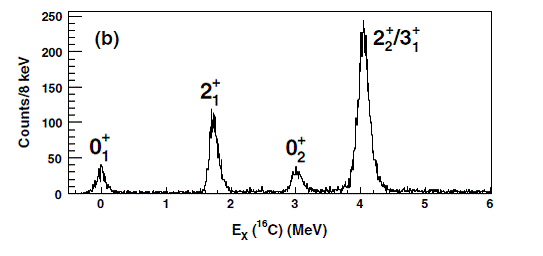Physics Division Research Highlights
Is there exotic behavior in the 16C isotope?
An important issue in the study of nuclei with a large neutron excess is how their properties are different from those of stable nuclei. Experiments carried mostly over the last decade have already uncovered a number of surprising results. For example, the existence of nuclear “magic” numbers has been called into question as a result of studies of nuclei that — in terms of their proton and neutron numbers —are far from the region of stable, naturally occurring isotopes. It seems that the large energy gaps that give rise to the extra stability of the magic nuclei are not all that robust and change with proton and neutron number. Another example is the presence of so-called neutron halos: while 4He is a very tightly bound object, 6He and 8He are not. Rather their matter radii are much larger, of a size comparable to that of 208Pb, and the additional neutrons gravitate around the 4He core at a large distance and form a halo. Recently, a number of experiments on neutron-rich carbon isotopes have suggested that the excess neutrons with respect to a 14C core, behave anomalously. The experimental evidence focussed mostly on the 16C isotope, where new data on the probability to populate the first excited state through a purely electromagnetic interaction as well as other inelastic scattering data were interpreted as signatures for a very exotic phenomenon: the decoupling of the motion of the last two neutrons from that of the 14C core.
A new experiment carried out at ATLAS has shed new light on the issue. Neutron transfer reactions represent an ideal experimental tool to directly probe the wave functions of the same states that were seen in the data alluded to above. In short, the 15C(d,p)16C neutron transfer reaction was used to investigate the strength with which the states of interest are populated in 16C. In order to do so, a radioactive 15C beam (half life: 0.75 second) had to first be prepared at ATLAS by bombarding a cryogenic deuterium target with a 14C beam. The resulting 15C beam with an energy of 123 MeV and an intensity of 2 x 106 15C per second was then sent onto a thin deuterated polyethelyne target and the 15C(d,p)16C reaction was investigated. This approach is often referred to as carrying out an experiment in inverse kinematics. If 15C had been stable it would have been used as a target and the bombardment would have occurred with a deuterium beam. Because of the short 15C half life the role of target and projectile had to be reversed, hence the name of the technique. The protons from the reaction were detected with the recently commissioned Helical Orbit Spectrometer [1], a new device specifically designed to study reactions in inverse kinematics.

Figure 1: Spectrum of the protons detected in the HELIOS spectrometer. The different peaks correspond to different final states in 16C. In particular, the first excited state (2+1) for with the excitation probability was thought to be anomalous in other, earlier measurements is clearly observed, but with a strength that does not require to invoke an exotic coupling of the last two neutrons to the 14C core.
The spectrum of protons from the reaction is given in Figure 1. Several states in 16C are populated in the reaction, including the first excited state mentioned above. The probability with which these states are populated through the direct transfer of a neutron could be determined with great accuracy. These results were then in turn compared with calculations. In the latter, two situations were considered: one where the two last neutrons in 16C behave as would be expected in a “classical” description and one where their behavior is indeed “exotic” and a decoupling of the two last neutrons from the core occurs. The agreement between experiment and calculations is remarkable and achieved only when the former hypothesis is applied. Thus, the suggestion that 16C is anomalous is not supported by the experiment and there appears to be no need to invoke very exotic phenomena. Further experimental work will be required to understand what might have gone wrong in the earlier measurements. A paper reporting these results has recently been published [2].
References:
- A.H. Wuosmaa et al., Nucl. Instrum. Methods Phys. Res., A 580, 1290 (2007) and
J.C. Lighthall et al., Nucl. Instrum. Methods Phys. Res., A 622, 97 (2010) - A.H. Wuosmaa et al., Phys. Rev. Lett. 105, 132501 (2010)
![[Argonne Logo]](/images/argonne_header_logo.jpg)
![[DOE Logo]](/images/header_doe.gif)